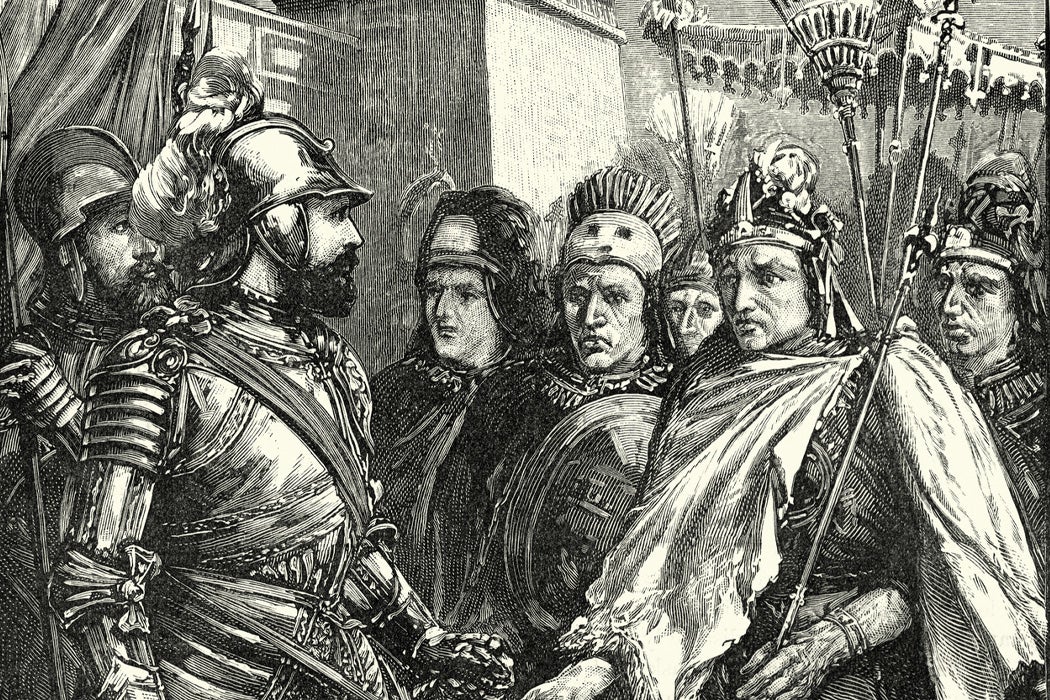The legend can be dated to 1552: Francisco López de Gómara was the first person to say that the Spaniards conquered Mexico because the conquistadors had been seen as gods by the indigenous people. López de Gómara had never been to Mexico, but he was chaplain and secretary to the retired Hernando Cortés, who had led the conquistadors.
Cortés own letters during the conquest make no mention of being mistaken for or interpreted as a god. Nonetheless, López de Gómara’s version quickly became the accepted story, writes the historian Camila Townsend, even among the post-conquest indigenous peoples. The fleshed-out version of the story had it that “a god named Quetzalcoatl, who long ago had disappeared in the east,” had promised to return on a certain date. By extraordinary coincidence, Cortés appeared out of the east in that very year. Seduced by their religious credulity, the Mexica—“Aztec” was a post-conquest term—were ripe for conquest by their “white gods.” As Townsend writes:
Today, most educated people in the United States, Europe, and Latin America are fully versed in this account[…]. In fact, however, these is little evidence that indigenous people ever seriously believed the newcomers were gods, and there is no meaningful evidence that any story about Quetzalcoatl’s returning from the east ever existed before the conquest.
Historians of early Mexico have buried the myth of the “white gods,” but this news hasn’t filtered into general knowledge. The story is clearly potent. After all, how else could just a few hundred Spaniards bring down a state with a capital city larger than any in Europe at the time?
Townsend argues that the “white gods” story is essentially political pornography, a dehumanizing narrative that equates technological with intellectual and moral superiority. Obviously, the “relatively powerful conquistadors and their cultural heirs should prefer to dwell on the Indians’ adulation for them rather than on their pain, rage, or attempted military defense.”
Superior technology, including the diseases that came with it, should be front and center in the history of the conquest. “The Mexicans themselves immediately became aware of the technology gap and responded to it with intelligence and savvy rather than wide-eyed talk of gods,” writes Townsend. “They knew before we did, it seems, that technology was the crux.”
Townsend says that two facts, seemingly counterintuitive, need to be considered about the conquest. One is that it was “much more difficult than is commonly imagined for the Spanish to vanquish the Aztecs.” The second is that the conquest was “inevitable,” either by Cortés, or by “some soon-to-follow expedition.” The Europeans “had the technological advantage,” as they did with Pizzaro against the Inca, de Soto against the Alabama, the English against the Algonkian, and “much later between Europeans and Africans.”
Weekly Newsletter
What were those technologies? Armor, crossbows, harquebuses, certainly—but also horses, which impressed the Mexica much more than the Spaniards did. The Spaniards had ships, which brought reinforcements and more disease. Cortés even had ship-builders who made boats used in the battle for Tenochtitlan. He had the printing press, indicative of a relatively rapid global communications system. By 1520, a year before the conquest was complete, Europeans were already looking at Aztec art, shipped over the Atlantic.
Townsend, who has recently published Fifth Sun: A New History of the Aztecs, and other historians of what we now call the Aztec Empire have deepened and complicated the history of the conquest. It’s not the just-so story we used to tell about it. The Mexica, led by the canny Moctezuma, were far from hapless, fatalistic, or omen-obsessed. But they were overwhelmed by the superior technological force ruthlessly used against them.
Support JSTOR Daily! Join our new membership program on Patreon today.







